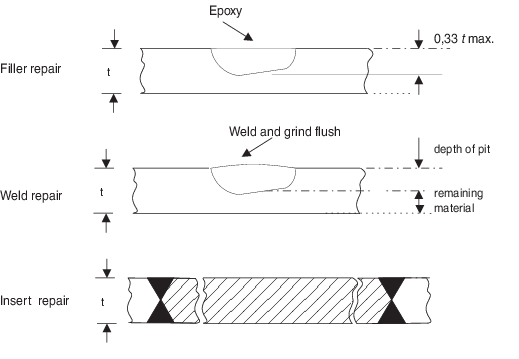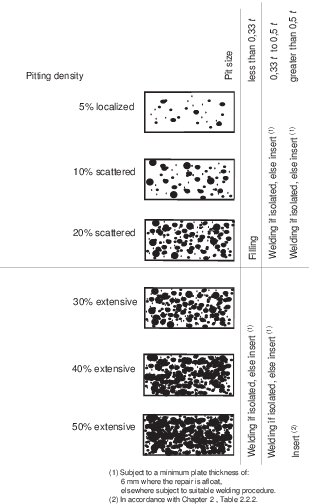1.1.1 Pitting results
from very localized corrosion and usually affects horizontal surfaces.
It can be found to be shallow or deep and with an intensity of localized,
scattered or extensive. See
Figure 12.1.2 Pitting intensity
1.1.2 Localized
shallow pitting less than 0,33t may be repaired by filling
with a suitable epoxy compound which should be applied in accordance
with the manufacturer’s instructions. See
Figure 12.1.1 Repair of pitting
1.1.3 Isolated deep
pits greater than 0,33t may be repaired by welding, provided
the thickness of material left at the bottom of the pit exceeds 6
mm. Where the repair is not carried out afloat, lesser thickness may
be welded where it can be demonstrated that the welder will not burn
through the plating. All welding or pitting is to be carried out in
accordance with established welding procedures. See
Figure 12.1.1 Repair of pitting
1.1.4 The pitting
must be suitably cleaned and prepared to permit a repair by welding.
The electrodes used are to be of an approved type from LR’s
list of approved welding consumables for use in ship construction,
suitable for the grade of steel to be welded. A minimum of four weld
beads are to be deposited in any pit. Care is to be taken to ensure
that stop and start positions are outside the pit and that the welding
direction is alternated for successive layers. Inspection of the welds
during and after repair should be supplemented by NDE methods for
the discovery of any surface cracks.
1.1.5 Where the
pitting intensity is found to be extensive (above 25 per cent of the
surface area) in association with deep pits (over 50 per cent of the
original fitted thickness), or where the thickness of material left
at the bottom of the pit is less than 6 mm, the affected plating should
be cropped and renewed. See
Figure 12.1.1 Repair of pitting
1.1.6 There have
been a number of instances where internal corrosion has occurred in
the bottom shell plating of oil tanks, especially in way of suction
strums, which has been undetected during previous surveys. Some of
this corrosion is being caused by bacterial attack (commonly known
as SRB - sulphate reducing bacteria) and may be localized or widespread.
This corrosion is also appearing within tanks where the bottom plating
forms part of a tank top.
1.1.7 SRB is often
very rapid localized pitting/erosion and hence early recognition/detection
may be critical in preventing a hole from forming.

Figure 12.1.1 Repair of pitting

Figure 12.1.2 Pitting intensity